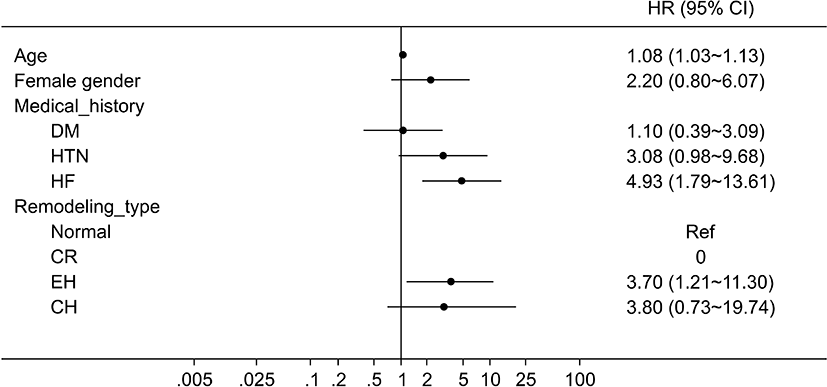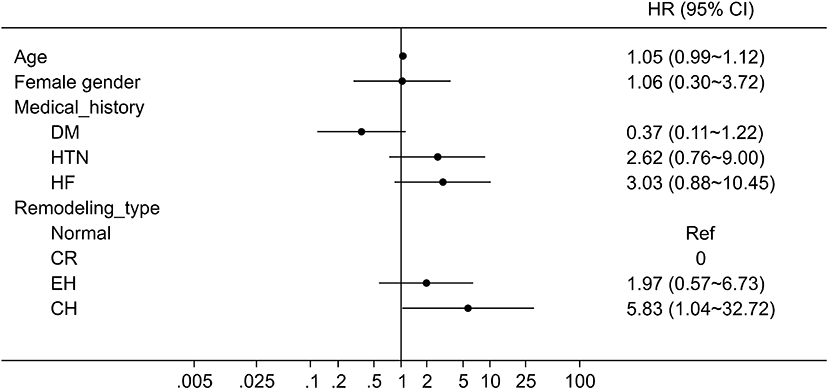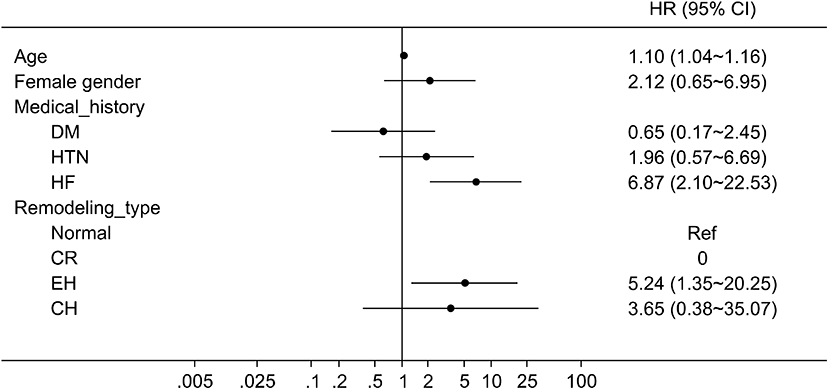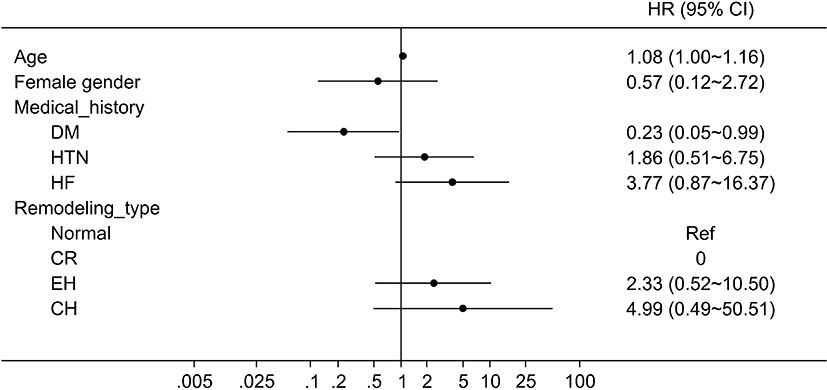Introduction
Left ventricular (LV) dysfunction begins with some injury or stress on the myocardium and is generally a progressive process [1,2]. The principal manifestation of such progression is a change in the geometry and structure of the LV, that the chamber dilates, hypertrophies and becomes more spherical. This process referred to as cardiac remodeling [1]. Such architectural remodeling can be classified as eccentric or concentric [3]. Concentric hypertrophy is a result of systolic pressure overload whereas eccentric hypertrophy is a consequence of volume overload [3].
The concepts of LV geometry were applied largely in clinical studies of patients with hypertension [4]. The adaptation of the LV to hypertension leads to the development of different geometric patterns and the differences of geometry are used as a risk stratification tool [5]. Hypertensive patients with concentric hypertrophy have the highest incidence of cardiovascular events including death [6]. Subsequently LV geometry was applied to the patients after acute myocardial infarction (AMI). In a high risk AMI, concentric hypertrophy carries the greatest risk of adverse cardiovascular events including death [7] but uncertainty still persists with the independent prognostic value of LV geometric patterns especially after AMI. To further characterize the various geometric patterns of the left ventricle and to determine the influence of those patterns on prognosis in patients with AMI, and to evaluate the difference of LV geometry by the type of ST change, we analyzed the patients who were diagnosed AMI with their echocardiographic data.
Methods
The 298 patients admitted to coronary care unit in Ewha Womans University Mokdong Hospital for AMI between January 2009 and October 2011 were included. The patients who were suitable for clinical and echocardiographic data were 256 and they were constituted for the final study group. Median duration of follow-up was 212.5 days (mean, 212±174 days). Fifteen patients (5.9%, 7 female [46.7%]) died during the duration of follow-up and the median duration of survival was 10 days (range, 1 to 386 days).
Comprehensive echocardiography performed within 3.0 days (3.0±18.3 days) after admission. LV septal wall thickness, posterior wall thickness and cavity size were measured from the LV short-axis view by two-dimensionally guided M-mode echocardiography, with images of the left ventricle at the papillary muscle tip level [8]. The LV mass was calculated according to the following formula: LV mass (g)=0.80×{1.04×[(septal wall thickness in diastole + LV internal diastolic diameter + posterior wall thickness in diastole)3 – (LV internal diastolic diameter)3]} + 0.6 g [7,9,10]. The LV mass was indexed to body surface area and LV hypertrophy was considered present when echocardiographically derived LV mass index (LVMI) was>115 g/m2 for men and >95 g/m2 for women [7,9]. The relative wall thickness (RWT) was calculated as 2×(posterior wall thickness in diastole)/(LV internal diastolic diameter). Increased RWT was present when this ratio was >0.42 [7,9]. The sample was divided into 4 mutually exclusive groups on the basis of LV geometry: concentric hypertrophy (LV hypertrophy and increased RWT), eccentric hypertrophy (LV hypertrophy and normal RWT), concentric remodeling (normal LVMI and increased RWT), and normal geometry (normal LVMI and normal RWT) [7,9].
Continuous data are presented as mean±standard deviation. Baseline data were compared by means of the χ2-test for categorical variables and unpaired t test for continuous variables. Comparison between the subgroups with different patterns of LV geometry was done using ANOVA with Scheffe post hoc correction. Multivariable cox proportional hazards models were used to determine the independent prognostic value of LV geometric patterns. Statistical analyses were performed using SPSS ver. 18.0 (SPSS Inc., Chicago, IL, USA). A probability value P<0.05 was considered statistically significant.
Results
LV geometry was classified into 4 groups. Eccentric hypertrophy was present in 75 patients (29.2%), concentric remodeling in 15 patients (5.9%), concentric hypertrophy in 14 patients (5.5%), and normal in 152 patients (59.4%). In total population, the mean age was 63.3±13.0 years and eighty patients were female (31.3%). Patients with eccentric hypertrophy and concentric hypertrophy were older than normal group and patients with eccentric hypertrophy were the oldest (P<0.001 to normal group). There was no significant difference of sex proportion between 4 groups. Medical history of diabetes mellitus (DM), hypertension, heart failure (HF), stroke
and myocardial infarction (MI) were included. Prevalence of DM and hypertension were higher in patients with concentric hypertrophy with no statistical significance. Prevalence of HF was significantly different between 4 groups (P=0.001) and the patients with eccentric hypertrophy showed the highest. In addition, patients with LV hypertrophy had lower estimated glomerular filtration rate and lower hemoglobin level (Table 1). The mean LVMI was 107.7±31.3 g/m2 (range, 49.9 to 253.3 g/m2) and the mean RWT was 0.34±0.08 (range, 0.13 to 0.66). The patients with LV hypertrophy had significantly lower ejection fraction, higher left atrial volume index (LAVI), higher E/e’ and severe mitral regurgitation (Table 2).
Type of ST change divided the patients into 2 groups. Patients with non ST elevation myocardial infarction (NSTEMI) were 147 (57.4%) and the patients with ST elevation myocardial infarction (STEMI) were 109 (42.6%). The patients with NSTEMI were older than the patients with STEMI (P<0.001). The patients with NSTEMI had higher female proportion than the patients with STEMI (P=0.004). In addition, the patients with NSTEMI had higher prevalence of DM (P=0.010), hypertension (P=0.001), HF P<0.001), stroke (P=0.004) and previous MI (P<0.001) significantly than the patients with STEMI. Whereas the patients with STEMI were younger (P<0.001), more likely to be men (P=0.004) and smokers (P=0.04) than the patients with NSTEMI. Additionally the patients with NSTEMI showed more eccentric hypertrophy significantly than the patients with STEMI (P=0.028), but the other LV geometric types were not significantly different. Besides patients with NSTEMI had lower estimated glomerular filtration rate and lower hemoglobin level (Table 3). Echocardiographic characteristics showed that the patients with NSTEMI had significantly higher LVMI and LAVI than the patients with STEMI (Table 4).
Of the 256 patients, 15 patients (5.9%, 7 female [46.7%]) died, and 11 patients of them (4.3%) experienced a cardiovascular death. After discharged, 7 patients (2.7%) had coronary artery bypass graft, 6 patients (2.3%) were readmitted with HF, 4 patients (1.6%) had recurrent MI, and 5 patients (2.0%) had stroke. The incidence of cardiovascular event including recurrent MI, admission due to heart failure, cardiac death and stroke were not significantly different between LV geometric types and between STEMI and NSTEMI (Table 5).
In an univariate analysis for all-cause mortality, age, history of HF and eccentric hypertrophy carried higher risk (Fig. 1) but in a multivariate analysis, only concentric hypertrophy carried the greatest risk of all cause mortality (hazard rations [HR], 5.83; 95% confidence interval [CI], 1.04 to 32.72) (Fig. 2).
In an univariate analysis for cardiovascular mortality, age, history of HF and eccentric hypertrophy carried higher risk (Fig. 3) but in a multivariate analysis, age carried higher risk and history of DM carried lower risk but no specific LV geometry had significantly higher risk for cardiovascular mortality (Fig. 4).
Discussion
Remodeling may be physiological and adaptive during normal growth or pathological due to myocardial infarction and hypertension [11]. After myocardial infarction, myocyte necrosis and the resultant increase in load initiates dilatation, hypertrophy, and the formation of a discrete collagen scar. Ventricular remodeling may continue until the distending forces are counterbalanced by the tensile strength of the collagen scar. This balance is determined by the size, location, and transmurality of the infarct and the patency of the infarct-related artery [12]. Many studies have tried to find the implication of LV geometry in AMI, but the differences in LV geometry between STEMI and NSTEMI have not been studied. Therefore this study tried to evaluate the differences of LV geometry between STEMI and NSTEMI and found that the patients with NSTEMI had higher co-morbidities and higher rate of eccentric hypertrophy than the patients with STEMI significantly, but adverse outcome was not different between STEMI and NSTEMI patients.
Changes in LV geometry and structure strongly associated with major cardiovascular events [1,13-17]. However, discerning the independent prognostic value afforded by alterations in LV shape has proved more controversial [17]. There have been many studies tried to perceive the prognostic implications of LV geometry. Initially, the concepts of LV geometry were applied largely in clinical studies of patients with hypertension [4,18]. Koren et al. [6] were among the first to use M-mode echocardiography to study the relationship of LV geometry to clinical outcomes and the study showed that hypertensive patients with concentric hypertrophy revealed the highest incidence of cardiovascular events including death [6,7]. Subsequently, LV morphologic changes in patients after AMI and the relationship of such findings to clinical course were studied [19-23]. LV end-systolic and end-diastolic volumes are effective metrics for the severity of post-MI remodeling, and their changes are closely associated with clinical outcomes [24]. Within broader populations, LV mass is a cardiovascular risk factor independent of blood pressure [13,16,23,24]. Recently, Verma et al. [7] related echocardiographic patterns of LV remodeling an average of 5 days after MI to the incidence of subsequent cardiovascular events. Patients with concentric hypertrophy are at greatest risk for the combined end point of cardiovascular death, recurrent MI, HF, stroke, or resuscitation after cardiac arrest [7,24].
In this study, the subdivided groups stratified by LV geometry showed significantly different outcome. Eccentric hypertrophy showed significantly higher risk for all cause mortality (HR, 3.70; 95% CI, 1.21 to 11.30) and cardiovascular mortality (HR, 5.24; 95% CI, 1.35 to 20.25) on univariate analysis. But after adjustment with age, sex, history of DM, hypertension and HF, the significance of mortality risk disappeared and only concentric hypertrophy showed the highest risk of all cause mortality (HR, 5.83; 95% CI, 1.04 to 32.72). Postinfarction remodeling is divided into two phases. The early phase involves expansion of the infarct zone and late remodeling involves time-dependent dilatation, the distortion of ventricular shape, and mural hypertrophy [11]. Therefore, by 5 days, the expected structural change after MI would be characterized by early dilation and eccentric hypertrophy [24]. However, in this study, the LV geometry with the greatest risk of mortality after MI was concentric hypertrophy [7,25]. Konstam [24] suspected that this could be explained by understanding the role of antecedent hypertension and its structural consequences on the clinical course after MI. The pathologic hypertrophy, particularly concentric hypertrophy represents a marker for the systemic consequences of hypertension, including vascular remodeling and results in both cerebral and myocardial ischemic events [24]. In this study [24] and the study by Verma et al. [7], the relative prevalence of hypertension follows the same patterns as the relative incidence of subsequent clinical outcomes: concentric hypertrophy had the greatest risk of hypertension and eccentric hypertrophy, concentric remodeling and normal pattern were followed. Conclusively we can hypothesize that at the time of MI, antecedent structural consequences of hypertension carry the LV geometric change and also higher risk of mortality rate.
The limitation of this study is followings. First, 2-dimensional echocardiography is limited in its accuracy for measuring LV mass because all methods assume a uniform LV thickness. Second, this result is based on the patients with AMI which limits generalization. Third, the already known predictors of cardiovascular mortality, e.g., initial Killip class and severity of coronary vascular disease were not analyzed in this study. Finally, this study did not assess for serial changes in LV mass and its geometrical patterns and potential influence on cardiovascular risk. Therefore prospective study with serial echocardiographic analysis should be followed.
In this report, patients with NSTEMI were more likely to have eccentric hypertrophy but adverse outcome after AMI was not different between STEMI and NSTEMI patients. The baseline LV geometry represents the prognostic predictors to the patients with AMI and the concentric hypertrophy carries the greatest risk of short term mortality. Therefore routine assessment of LV mass and RWT can help us to assess the prognosis of the patients with AMI.



